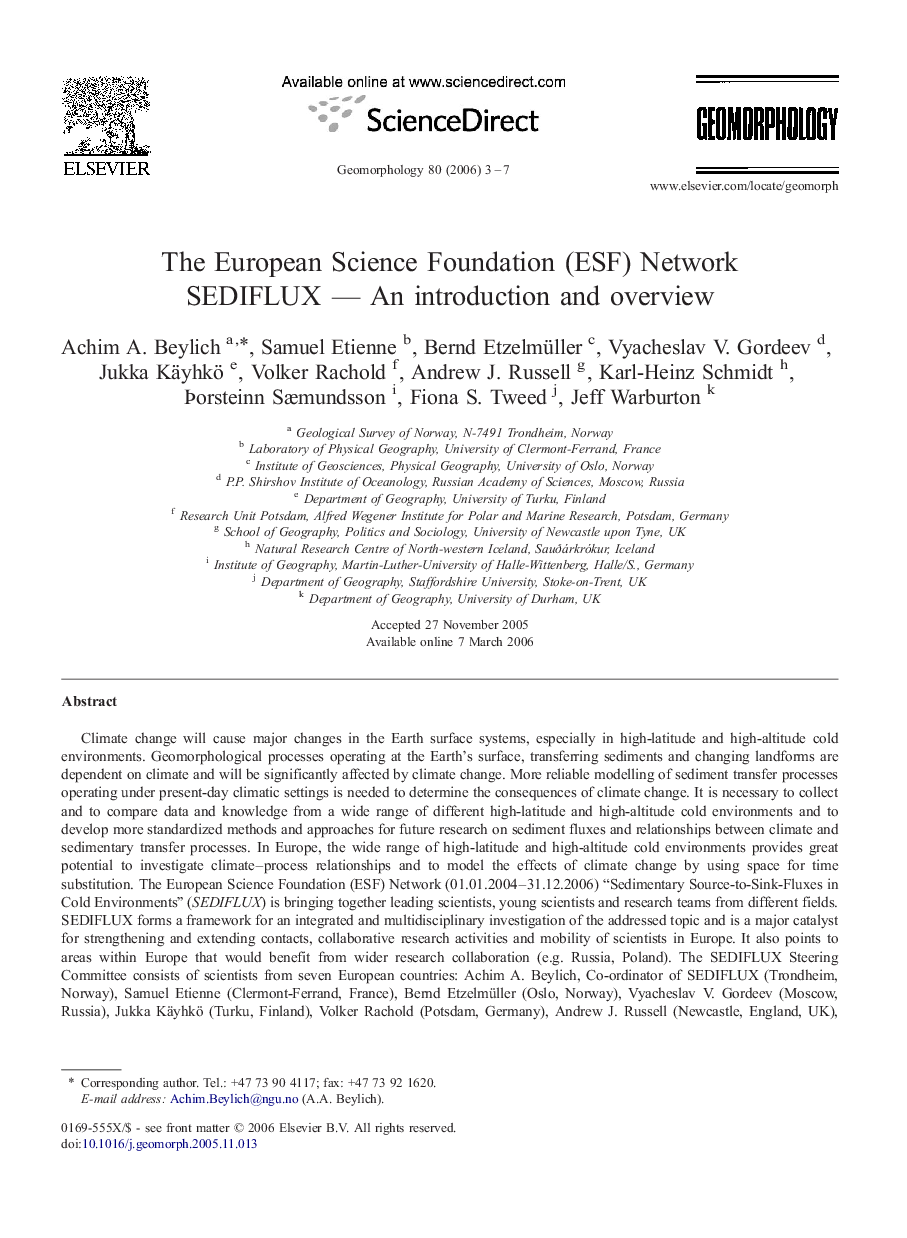| کد مقاله | کد نشریه | سال انتشار | مقاله انگلیسی | نسخه تمام متن |
|---|---|---|---|---|
| 4687532 | 1635592 | 2006 | 5 صفحه PDF | دانلود رایگان |

Climate change will cause major changes in the Earth surface systems, especially in high-latitude and high-altitude cold environments. Geomorphological processes operating at the Earth's surface, transferring sediments and changing landforms are dependent on climate and will be significantly affected by climate change. More reliable modelling of sediment transfer processes operating under present-day climatic settings is needed to determine the consequences of climate change. It is necessary to collect and to compare data and knowledge from a wide range of different high-latitude and high-altitude cold environments and to develop more standardized methods and approaches for future research on sediment fluxes and relationships between climate and sedimentary transfer processes. In Europe, the wide range of high-latitude and high-altitude cold environments provides great potential to investigate climate–process relationships and to model the effects of climate change by using space for time substitution. The European Science Foundation (ESF) Network (01.01.2004–31.12.2006) “Sedimentary Source-to-Sink-Fluxes in Cold Environments” (SEDIFLUX) is bringing together leading scientists, young scientists and research teams from different fields. SEDIFLUX forms a framework for an integrated and multidisciplinary investigation of the addressed topic and is a major catalyst for strengthening and extending contacts, collaborative research activities and mobility of scientists in Europe. It also points to areas within Europe that would benefit from wider research collaboration (e.g. Russia, Poland). The SEDIFLUX Steering Committee consists of scientists from seven European countries: Achim A. Beylich, Co-ordinator of SEDIFLUX (Trondheim, Norway), Samuel Etienne (Clermont-Ferrand, France), Bernd Etzelmüller (Oslo, Norway), Vyacheslav V. Gordeev (Moscow, Russia), Jukka Käyhkö (Turku, Finland), Volker Rachold (Potsdam, Germany), Andrew J. Russell (Newcastle, England, UK), Karl-Heinz Schmidt (Halle/S., Germany), Þorsteinn Sæmundsson (Sauðárkrókur, Iceland), Fiona S. Tweed (Staffordshire, England, UK) and Jeff Warburton (Durham, England, UK). SEDIFLUX activities include four Science Meetings: in Sauðárkrókur, Iceland (June 18th–June 21st, 2004), Clermont-Ferrand, France (January 20th–22nd, 2005), Durham, England, UK (December 15th–20th, 2005) and Trondheim, Norway (October 29th–November 1st, 2006), Steering Committee Meetings attached to these Science Meetings, a Session co-organized by SEDIFLUX at the Second European Permafrost Conference, June 12th–17th, 2005, in Potsdam, Germany, publication of Scientific Reports and Abstract Volumes, publication of Special Issues of Journals and of a SEDIFLUX Handbook, creation of a SEDIFLUX Database, an effective diffusion and dissemination of SEDIFLUX activities and outputs by using electronic media (Websites, Newsletters, Forum), invitations of leading experts from other parts of the world, policy makers and land managers to the Science Meetings. The ESF Network SEDIFLUX is organized in four Working Groups: I: Selection of critical test catchments; II: Analysis of geographical and geological settings of test catchments; III: Analysis of present-day fluxes; IV: Integration and data management. The major outputs from the Working Groups will be published in the SEDIFLUX Handbook, including guidelines for future monitoring programmes and a section, which is particularly targeted at end-users. A strong monitoring and operational data collection and more standardized methods provide a baseline for the development of reliable models and for future research in the changing high-latitude and high-altitude cold environments. ESF SEDIFLUX will continue and will be extended as I.A.G./A.I.G. Working Group on Sediment Budgets in Cold Environments (SEDIBUD). Apart from further collaborations and collaborative research activities project and programme applications at both the national and the European level following the three-year ESF Network are discussed and initiated.
Journal: Geomorphology - Volume 80, Issues 1–2, 20 October 2006, Pages 3–7